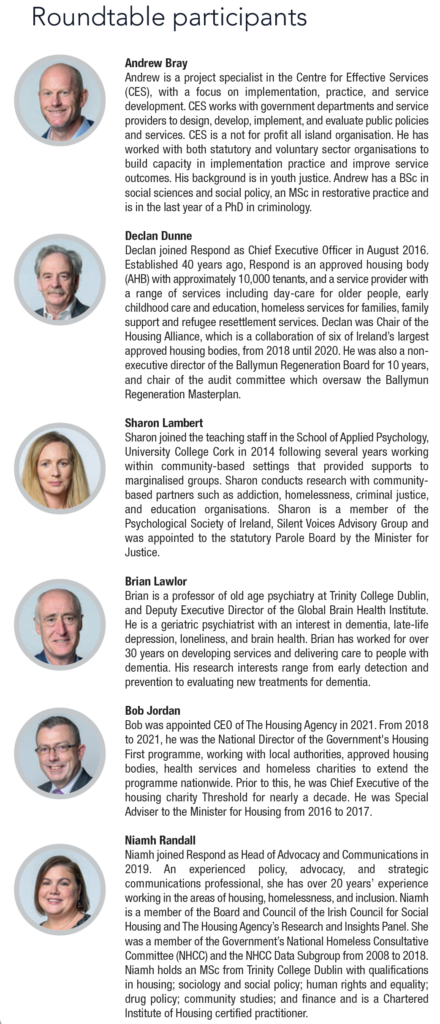More than ‘bricks and mortar’: Delivering effective services and interventions for tenants
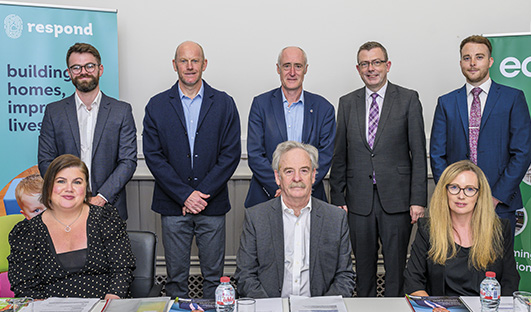
Round table discussion hosted by

Respond, a leading Approved Housing Body and community services provider, hosted a roundtable discussion with key stakeholders across the housing and health sectors to look beyond the homes provided and discuss the holistic value of services for tenants.
What role do social housing stakeholders play in cultivating inclusive and sustainable communities?
Niamh Randall
Our belief is that our relationship with our tenants starts when they move into their homes. We have a key role in ensuring that our communities are diverse and inclusive, and in ensuring that we are responsive to those who face challenges. We want to become a trauma-informed organisation, identifying issues and intervening at an early stage to prevent issues from escalating. We see ourselves as a social justice organisation and we are focused on equality and equity in terms of outcomes. Quality homes are essential, but it is the delivery of a lifetime relationship with our tenants that is vital to our organisation.
Andrew Bray
When cultivating inclusive and diverse communities, they must integrate within existing communities as well. For example, there is a Respond community in Charlestown, but it is contextualised within a larger community. Within mixed-tenure communities, it is necessary to determine the limits of Respond’s role and where other stakeholders and services take over when it comes to creating larger inclusive communities. We must be proactive in terms of planning ahead; that is where social justice, trauma-informed care, and brain health initiatives are relevant. This was a factor in the design of the tenant engagement service that CES recently completed with Respond.
Declan Dunne
Taking a large development we have been working on recently as an example, we built over car parks and next to a shopping centre. A huge amount of thought went into assessing what it would be like for people living there and we have a big responsibility not to let them down in terms of the quality and safety of their homes, to enable them to thrive. It is about being available to offer support when needed.
Sharon Lambert
It is about not revisiting mistakes we have made in the past. Our expectations for people in social housing communities should be the same as people in any other community. For example, if you go anywhere in Cork city, you see symbols connected to educational and other community institutions; when you go to the Northside, however, these are absent. The stigma that is attached to social housing is where the other stakeholders assume relevance. The State and the media must not allow people to use expressions such as ‘free housing’. People should understand what social housing is. We must make sure that social housing tenants are part of the broader community rather than an appendage on the side of it.
Brian Lawlor
A framework is important. Self-actualisation and wellbeing are at the top of a pyramid of needs, but the bottom of that pyramid are the basic needs such as shelter, a home, and support. We need to cultivate that sense of safety and security. Using the lens of brain health to create sustainable and inclusive communities is useful because what we are trying to do is connect people across a vibrant community in a way that will be stimulating and promote their brain health. The framework should be built on a concept of ‘home first’ and connecting that home to the community so people can flourish.
Bob Jordan
Under Housing for All, 40 per cent of new social homes provided by 2026 will be delivered by the approved housing body [AHB] sector. AHBs are central to delivering government targets. Tenants need security of tenure and affordability, but they also need to feel confident that their landlord is interested in them individually. The AHB sector has been to the forefront of providing housing that meets the needs of disabled people, people exiting homelessness, older people, and others. An exciting prospect is the sector getting involved in cost rental housing; by being involved in both cost rental and social housing, AHBs can help deliver mixed tenure communities.
What are the most significant challenges in relation to the needs of social housing tenants?
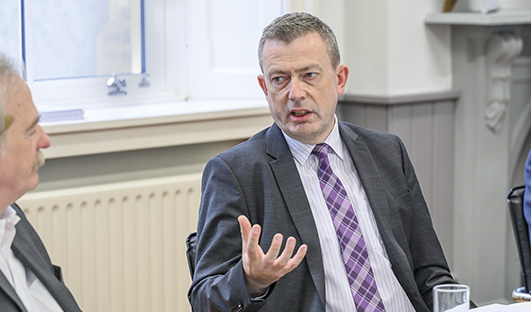
“We cannot have sustainable communities without tenant engagement and promoting the benefits of this approach should be a shared goal of AHBs and local authorities.”
Bob Jordan
Bob Jordan
Supply is the key challenge and output must be increased to ensure we deliver 90,000 new social homes by 2030. We need to have affordable housing options; social housing is means tested and there are many people who do not qualify for it but who also cannot afford to rent or buy in the private market. Dealing with that affordability gap is important. We also need to provide right-sizing opportunities for older people. In doing all these things, we must ensure we do not forget communities. There is a risk when we focus on ramping up supply and addressing affordability that we do not focus enough on creating sustainable communities. This can store up problems for the future.
Brian Lawlor
There is an important challenge around training and education of staff so that they understand the complex needs of their tenants or clients. It is also not just about how you apply the brain health approach to support tenants, but how you apply it to staff as well and how staff look to build their own resilience. This is tough work, and we want to retain high-quality staff, so we need to support and enable staff to look after their own brain health as well as that of their clients.
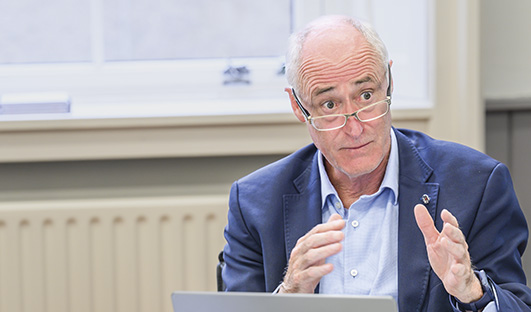
“There are far too many negative stereotypes associated with homeless people and our society does not appear to have much empathy for people that are experiencing homelessness.”
Brian Lawlor
Niamh Randall
A challenge facing everyone in Ireland is housing affordability. The challenge is delivering the right type of supply in the right places. Cost rental is one of the solutions in terms of the affordable housing model and it is a gamechanger. There is significant pressure on our rate of delivery and there are people working hard to improve that. What sets social housing tenants apart is income. This means they are particularly exposed to the cost of living crisis. This will become even more challenging as winter approaches and people will be under pressure to heat their homes. As well as mixed-tenure communities, we need to strive for mixed-income communities; people should be living side-by-side and it should not be obvious who is and is not living in social housing.

“Our belief is that our relationship with our tenants starts when they move into their homes.”
Niamh Randall
Sharon Lambert
It is about financial and social capital. Low-income workers are less likely to have enough money to survive, but they also lack opportunities. One of the ways to address that challenge is to cultivate mixed-income communities.
Andrew Bray
We must think about the needs of social housing tenants on a personal level. Many social housing tenants have other complex needs including mental and physical ill health and the challenge is to meet those needs and to support individuals to meet their own needs. However, if an individual is worried about having shelter over their head, all other priorities go out the window. The significant challenge for AHBs is ensuring those needs are met holistically and that requires agility and flexibility on the ground. AHBs cannot do everything; they undertake housing delivery and engagement well, but they need support to provide the right services to people as and when they need them.
Declan Dunne
It is important to consider applying a tailored universalism approach to ensure universal outcomes. Cognisant that rural Ireland is different to urban Ireland, for example, alongside variations in people’s expectations, we are trying to tailor our work while ensuring consistent outcomes. At the same time, cost of living pressures and the available resources from the State are also a challenge. We have been through similar experiences before and historically they end with expenditure being cut, particularly in community services. By nature, a lot of the families we accommodate include children and as such, youth work is a significant area of work that needs some focus.
How significant is the relationship between health and housing?
Sharon Lambert
When we think about psychological trauma, we tend to think of abuse and neglect, but we know that poverty and discrimination have a similar impact on development. Stress impacts on behaviour and thinking, so we need housing services to be able to account for support mechanisms. Stability helps to set up a child for life at school, with friendships, and other important aspects of their mental and physical health and will propel them to achieve their educational goals as adults.
Niamh Randall
Health is a key determinant of housing; the poorer the quality of housing the poorer one’s health will be. Those in emergency accommodation or rough sleeping often have the poorest health. There is also intergenerational trauma; families who have faced constant crises often have cumulative trauma. Resilience can often be based on the depth of social capital, stability, and a strong support network. We need a trauma-informed response to ensure that nobody feels alienated in our society. Housing security and stability is good for the tenant, but it is also good for staff working with them too.
Andrew Bray
Alongside social capital and economic capital, there is also cultural capital. There needs to be an understanding of the necessity of the transferability of these. If there is a strong level of social and cultural capital, then there will invariably be a strong level of economic capital which in turn can lead to improved health.
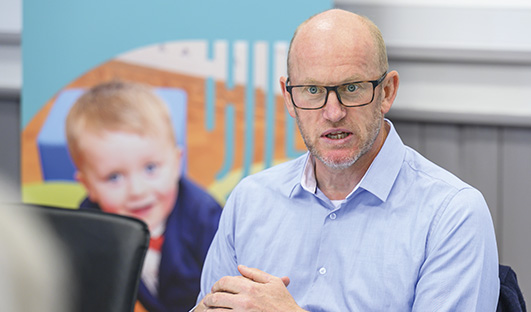
“The right to housing should be a priority. Underneath that, common purpose is important and so too is evidence-based solutions and services.”
Andrew Bray
Health needs to be explored beyond its normalised understanding; we need to look at the bigger picture and understand the impact that housing instability has on people’s health. Having a well-trained staff who can deal with people’s traumatic incidents is crucial in reducing stress.
Bob Jordan
During the Covid-19 pandemic, we saw a joint health and housing response to homelessness deliver incredible results. Rough sleeping was reduced to a minimum and people were given the health supports they needed. Housing First provides people with a history of rough sleeping and long-term homelessness with a permanent home, as well as intensive supports for mental health and addiction. People who have been rough sleeping for many years have remained permanently out of homelessness in up to 90 per cent of cases.
Brian Lawlor
There are far too many negative stereotypes associated with homeless people and our society does not appear to have much empathy for people that are experiencing homelessness. There is a lack of appreciation of how easy it is to fall into homelessness. The current ‘rent generation’ are increasingly vulnerable to experiencing homelessness as they get older. We need to remove the stigma of homelessness so that people receive greater empathy and understanding.
Housing instability is a major determinant of health and health outcomes. We know that 80 per cent of health is socially determined and housing instability is one of these social determinants. Investing in affordable housing will really improve health outcomes and ease some of the burden on the health service. There is a bi-directional aspect to all of this; housing instability causes poor brain health, but people with poor physical or mental health are also more likely to fall into homelessness. The first 10 years of a child’s life is so important for brain development and brain plasticity; access to stable housing and education are crucial to determining their brain health. In adolescence, housing instability affects social relationships, mental maturation, and the ability to self-regulate. In adulthood, housing instability results in stress and poor lifestyle choices, which can lead to an increased risk of dementia in later life. Housing is a health issue, and how we message this is crucial to reducing the stigma associated with housing instability and homelessness.
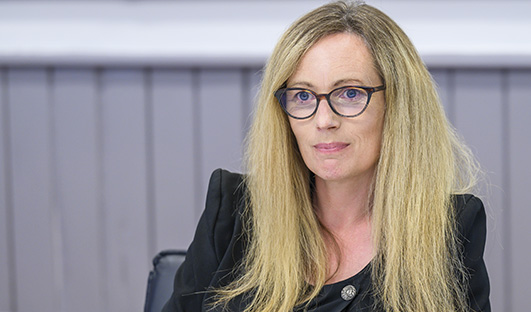
“The stigma that is attached to social housing is where the other stakeholders assume relevance. The State and the media must not allow people to use expressions such as ‘free housing’.”
Sharon Lambert
Sharon Lambert
We need more participation and representation from working class communities in all sectors and decision-making spaces of society. Working class people need to be enabled to build communities from the ground up. Having mixed types of social housing is a crucial part of this, so that social housing areas are not seen as ‘poor areas’ with ‘people who are not able to function’. If we do that, we will have much more social cohesion and a path to eroding the stigma which exists towards homeless people.
Declan Dunne
Ultimately, a beautiful home to which a child will be proud to bring their friends is what we must aspire to. A child needs to be supported and not be judged based on class in their engagements with the justice system, the health system or housing. As for housing itself, we are not repeating mistakes of the past whereby social houses are tiny and cramped and where they have minimal light, and a small or no garden, as though ‘this is all they deserve’. People deserve the best and that is what we are doing in Ireland. Having support networks which go beyond the traditional understanding of the nuclear family is also crucial to ensuring that people are not left behind. There are a lot of things to be hopeful about with housing in Ireland, and we are moving in the right direction.
Brian Lawlor
There is a stigma attached to the term ‘social housing’ and the notion of ‘free housing’ is unhelpful. Many people automatically associate ‘social housing’ with low socio-economic status but, going forward, this will not be the case. We should consider revising the terminology and use the term ‘equitable housing’.
How significant is an evidence-based approach to working with and engaging social housing tenants?
Brian Lawlor
Data and evidence are important to developing policy and practice and in working with tenants and clients. Having an evidence-based approach is helpful for staff and can improve their understanding of the perspective of the person they are working with and why they are delivering care in a particular way.
Andrew Bray
At CES, we translate evidence into services and implementation across a wide range of sectors including health, education, justice, and housing. Evidence is more than just the findings of academic research; it is about the lived experience of people across social housing and a vast range of other sectors. Engaging with people from different backgrounds is important. We must be imaginative in how we engage with groups who are hard to reach and getting evidence from lived experience is critical in informing staff. CES’s responsibility is to determine why some schemes work and what the context is which allows them to flourish; it is a national service with a local response, and every context is different.
Bob Jordan
The most important thing is gathering the evidence from the people who are affected by the problem. The Housing Agency has a role in supporting research as we did with NUI Galway and Community Action Network in a study of tenant participation in local authority housing. We cannot have sustainable communities without tenant engagement and promoting the benefits of this approach should be a shared goal of AHBs and local authorities.
Declan Dunne
The participation ladder distinguishes what is meaningful and what is tokenistic engagement. It is not always straightforward to establish an engagement process. Getting the right statistics about, for example, parents or people with disabilities, makes all the difference when to comes to this. Polling and inviting people to engage can be very effective.
Tenant engagement is a strategic goal of Respond. There is a mix of methodology, and we have a long way to go but the process is underway, and the strategy gives us the means to go forward.
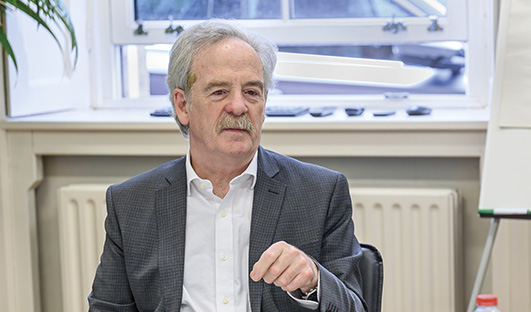
“Ultimately, a beautiful home to which a child will be proud to bring their friends is what we must aspire to.” Declan Dunne
Sharon Lambert
Evidence-based means that it is developmentally appropriate, taking brain health, neuroscience, and psychology into account. We know a lot about the differentiation of needs of people of different age groups. Having an evidence-based approach to housing requires layers; it should be developmentally informed. We know a lot about the differentiation of needs of people of different age groups. For instance, children hanging around in large groups, especially as adolescents, is developmentally appropriate. Therefore, how do we design where they live, rather than complain about them doing what they are supposed to be doing?
Simultaneously, we should have key performance indicators (KPIs) and ensure that they are framed in the interests of the people they are concerning. We need to ensure that KPIs target quality rather than quantity.
Niamh Randall
There is an obligation to act upon what the evidence tells us. Research is only good if there is a dissemination strategy to ensure that the message reaches the people who need to hear it. As for implementation, we all see fantastic research reports, but they sometimes do very little to change anything on the ground. We need rigorous implementation and that means having an implementation plan.
What is the single most important factor informing the future of social housing?
Declan Dunne
I think it is common purpose. I think we are in a good place and there is some great collaboration driven by the fact that there is a crisis, and it requires urgent response. It is a significant responsibility but also a great privilege and the challenge for all of us is to find new solutions, new actions and to move quicker. If I had to identify a single challenge, it would be planning and the time it takes to deliver housing.
Bob Jordan
That social housing be recognised as the central component of successful mixed-tenure and mixed-income communities. Additionally, Housing for All has a focus in moving AHBs towards direct construction. Planning and the availability of land are seen as barriers to that currently, but I would like to see the AHB sector taking control of all aspects of housing provision including direct construction.
Sharon Lambert
I believe it is trauma-sensitive inter-agency collaboration across all public bodies. Housing First is an incredibly successful concept, building in services to support the individual around housing. If every single public body had the same common purpose and the same understanding of the impact of stress on thinking and behaviour, services would be available equally and we would build a much better future.
Andrew Bray
The right to housing should be a priority. Underneath that, common purpose is important and so too is evidence-based solutions and services. We need to ensure that we are using evidence-informed practices to enable agility and flexibility to meet the changing needs of tenants and other service users.
Niamh Randall
The right to housing is one of our guiding principles in Respond. Ireland has strong private property rights within the Constitution, but we need to find a balance so that decisions being made on a constitutional basis are balancing the right to private property with the right to housing.

